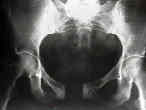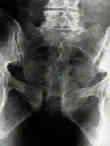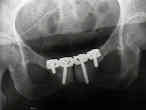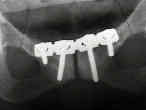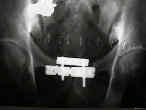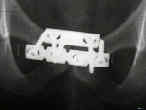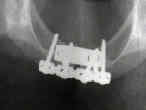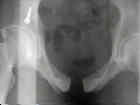 - Two Hole Implants:
- Two Hole Implants:- two hole plate, usually a 4.5 mm, is fixed to the superior surface of the symphysis with two
6.5 mm cancellous screws immediately adjacent to the symphysis pubis;
- screws are inserted on the anterosuperior surface of the pubis on either side of the symphysis
and directed to the full depth of pubis in a posteroinferior direction;
- to provide satisfactory fixation, 6.5-mm cancellous screws with 32-mm threads are used and they should
penetrate full depth of pubis;
- usually, screws of 50-55 mm in length can be accommodated;
- implant appears to loosen to point of accommodating physiologic motion at symphysis pubis, yet adequately resists tensile stresses
across symphysis without loss of reduction;
- fixation failures w/ two hole implants are more common w/ osteoporotic bone;
- references:
- Two-Hole Plate Fixation for Traumatic Symphysis Pubis Diastasis.
- Comparative radiographic and clinical outcome of two-hole and multi-hole symphyseal plating.

- Four Hole Implants:
- indicated for anterior diastasis w/ or w/o an unstable posterior injury;
- fixation usually involves a contoured 4.5 mm reconstructive plate applied to the superior surface
surface of the pubis;
- usually, fully threaded cancellous screws are used to secure the plate;
- four-hole plate fixation, while maintaining reduction of diastasis, does not allow motion across joint & may
be prone to late problems of loosening or implant fatigue;
- locking plates:
- references:
- Locked versus standard unlocked plating of symphysis pubis in a Type-C pelvic injury: A cadaver biomechanical study.
- Locked versus Standard Unlocked Plating of the Pubic Symphysis: A Cadaver Biomechanical Study.
- Failure of Locked Design-Specific Plate Fixation of the Pubic Symphysis: A Report of Six Cases.
- Biomechanical Study of 4-hole Pubic Symphyseal Plating: Locked Versus Unlocked Constructs
- reference:
- Comparative radiographic and clinical outcome of two-hole and multi-hole symphyseal plating
- Combined Two and Four Hole Plates:
- the anterior plate may consist of a 3.5 or a 4.5 mm reconstruction plate;
- the plate is usually secured w/ 4.5 mm cortical screws;
- indications are mainly for unstable posterior injury;
- Box Plate Fixation:
- allows for superior fixation in osteoporotic bone;
- utilizes two 2-hole narrow 4.5 DCP plates placed parallel to each other, one above and one below the the pubic symphysis;
- the inferior plate is recessed w/ in the symphysis;
- the plates are inter-locked utilizing two 6.5 mm screws;
- reference:
- Box Plate Fixation of the Symphysis Pubis: Biomechanical Evaluation of a New Technique.
- Fixation of Pubic Symphyseal Disruptions: One or Two Plates?
Comparative radiographic and clinical outcome of two-hole and multi-hole symphyseal plating.
The effect of implant failure after symphyseal plating on functional outcome and general health.



